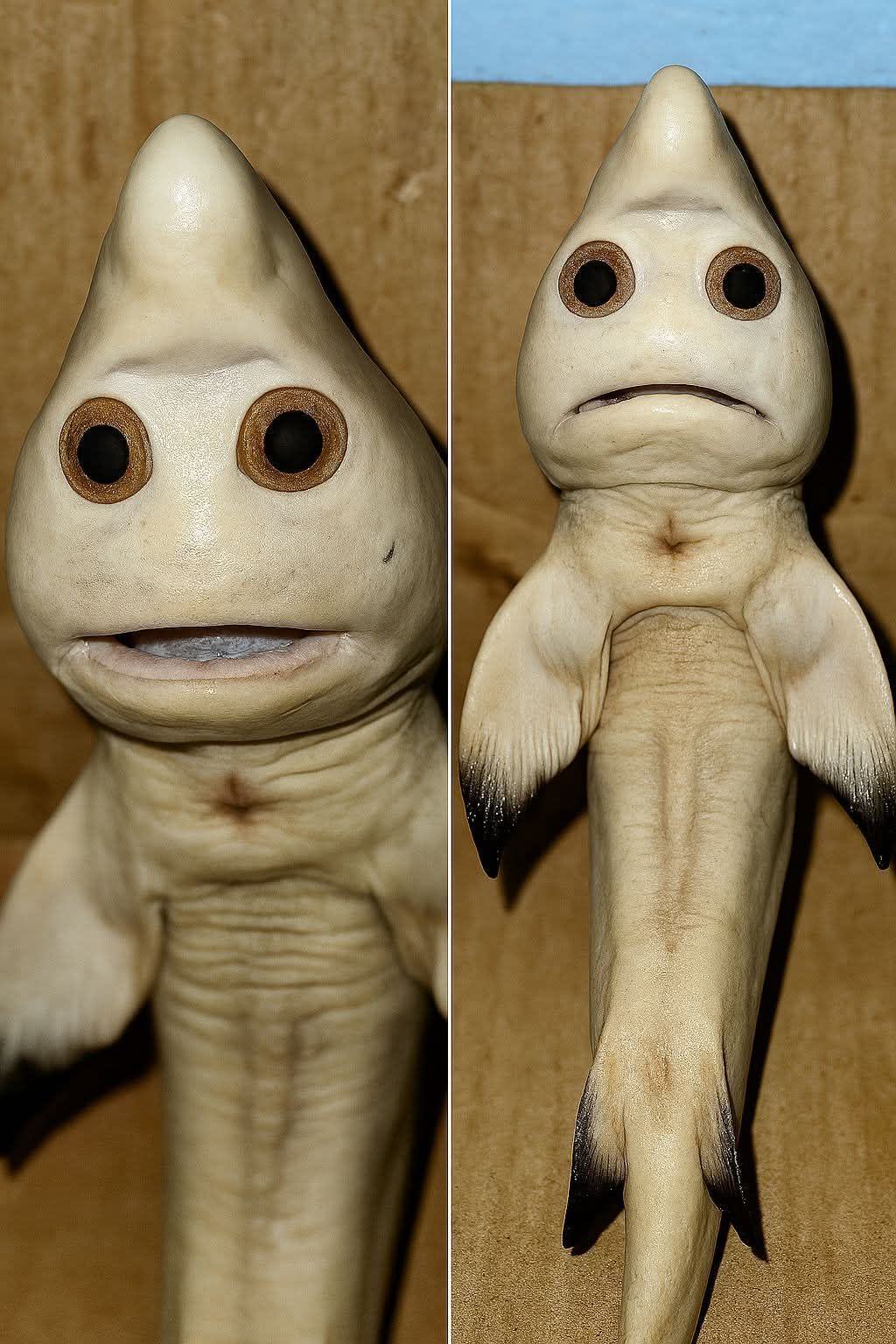The Cyclops Shark: Nature’s One-Eyed Mystery

The Cyclops Shark: Nature’s One-Eyed Mystery

A Glimpse Into the Unknown
The oceans of Earth are filled with countless strange and mysterious creatures, many of which remain undiscovered. Every so often, nature surprises scientists with anomalies that challenge our understanding of biology and evolution. One such discovery shocked the scientific community and the public alike—a rare cyclops shark, a creature that seemed to leap from mythology into reality. With a single, central eye and a distinctly human-like expression, the cyclops shark is a rare specimen that opens up new dialogues about marine biology, deformities, and the fragile beauty of life beneath the waves.
What Is the Cyclops Shark?
The term “Cyclops shark” refers to a malformed fetus of a dusky shark (Carcharhinus obscurus) or a similar shark species. This specimen was found inside a pregnant shark that was captured by commercial fishermen near the Gulf of California in 2011. While the adult shark was part of a regular catch, one of the eleven embryos inside her belly stood out—it had a single, centrally located eye on its forehead and lacked the usual two eye sockets.
The condition the embryo suffered from is known as cyclopia, a congenital disorder characterized by the failure of the embryonic prosencephalon (forebrain) to properly divide the orbits of the eye into two cavities. As a result, the creature develops only a single eye or partially fused eyes located in the center of the face.
Although similar cases have occasionally been reported in other animals—including goats, cats, and humans—cyclopia is extremely rare and almost always fatal. The cyclops shark was no exception; it was stillborn and unlikely would have survived in the wild.
The Anatomy of the Cyclops Shark
At first glance, the cyclops shark might seem like something from a sci-fi film. Its eerie appearance—accentuated by the smooth, white body and single, bulging eye—gives it an almost puppet-like expression. The creature exhibits the typical external features of a dusky shark embryo: soft, unformed cartilage structure, a pointed snout, and underdeveloped fins. Yet what makes it an extraordinary specimen is:
-
Single central eye socket: Located where the forehead would be, the eye appears fully developed but without the protective cartilage around it.
-
Absence of normal facial symmetry: The face is devoid of traditional shark eye placement, giving the animal a bizarrely symmetrical but alien appearance.
-
Soft body texture: Like all shark embryos, the body had not yet calcified, giving it a rubbery, pale look.
Photos of the specimen went viral online, captivating audiences not just for its strangeness, but also for the almost cartoon-like or human expression it bore.
Cyclopia: The Science Behind the Deformity
Cyclopia is classified as a form of holoprosencephaly, a spectrum of brain malformations resulting from improper forebrain development during early gestation. It can be caused by several genetic mutations, environmental toxins, or nutritional deficiencies.
In animals and humans alike, cyclopia is typically accompanied by:
-
Brain and skull malformations
-
A single median eye or partially fused eyeballs
-
Lack of nasal cavities or a proboscis-like structure above the eye
-
Underdeveloped or misplaced internal organs
In the case of the cyclops shark, it is likely that a spontaneous mutation during embryonic development led to the deformity. The mother shark’s health or environmental factors may also have contributed, although no definitive cause was established.

Discovery and Verification
When the cyclops shark was discovered by local fishermen, it was initially met with disbelief. Fortunately, instead of being discarded, it was preserved in formaldehyde and handed over to scientists at Mexico’s Interdisciplinary Center of Marine Sciences (CICIMAR-IPN) for examination.
Marine biologist Felipe Galván-Magaña, who led the study, confirmed that the eye was not artificially inserted or manipulated. Using X-ray imaging and dissection, researchers verified the presence of a single optic nerve connecting the eye to the brain. This confirmed that the eye developed naturally within the embryo—a genuine case of cyclopia.
Such scientific diligence was necessary, especially in an age of digital manipulation where skepticism can run high. The verification of the cyclops shark as a real biological phenomenon was key to its credibility in academic circles and public discourse.
Other Cases and Reports
While the 2011 cyclops shark is the most well-documented case, it is not the only one. There have been other anecdotal or unverified reports of cyclopic sharks:
-
In 2005, a fisherman in Indonesia claimed to have caught a shark embryo with a single eye.
-
In 2016, images surfaced of a similarly deformed embryo discovered in Maluku, Indonesia.
-
In 2020, a baby shark with a single eye was reported in Indonesia again, though many of these cases were never formally studied or verified.
Despite these sporadic findings, such deformities remain incredibly rare—likely occurring in fewer than 1 in 100,000 shark births.
Mythology and Cultural Impact
Cyclops creatures have a long-standing presence in mythology. The term “cyclops” originates from Greek mythology, where Cyclopes were giant one-eyed beings—builders, blacksmiths, or monstrous figures like Polyphemus in Homer’s Odyssey. These creatures often symbolized wild, untamed nature or represented divine craftsmanship.
The cyclops shark, with its uncanny appearance, seems to echo these mythological motifs, blurring the lines between legend and science. Its discovery fascinated not just scientists but also artists, meme creators, and storytellers, becoming a viral phenomenon across social media platforms. People anthropomorphized the shark, imagining it as a cartoon or assigning it emotional expressions.
Ethical Considerations and Conservation
The fascination with the cyclops shark also raises important ethical questions. Should rare deformities be preserved, displayed, or left alone? Is the viral sharing of such images respectful to the creatures involved, or does it trivialize scientific discovery?
In this case, the embryo was already deceased and used for genuine research purposes. Scientists gained insights into shark embryology, genetic mutation, and development by studying it.
However, it’s important to note that sharks as a species face far greater threats. With over 100 million sharks killed each year due to overfishing, finning, and habitat destruction, the biggest danger to sharks is not deformity—but humanity.
The cyclops shark, while an anomaly, serves as a stark reminder of how little we know about the oceans and their inhabitants. It invites us to learn, respect, and conserve rather than exploit.
Why It Matters: The Value of Rare Discoveries
The cyclops shark may be a biological accident, but it offers scientists a valuable window into embryonic development and evolution. Here’s why discoveries like this matter:
-
Understanding development: Studying deformities helps researchers identify key stages in embryological development and what can go wrong.
-
Medical parallels: While human and shark biology differ greatly, shared genetic processes mean such research can inform medical understanding of birth defects.
-
Biodiversity insight: Even rare anomalies enrich our understanding of marine biodiversity and natural variation.
-
Public engagement: Cases like the cyclops shark captivate public imagination and promote interest in marine science and conservation.

A Glimpse Into Evolution’s Whimsy
The cyclops shark is more than just a marine curiosity. It’s a poignant symbol of nature’s unpredictability—where even the rarest deviations reveal the complex machinery of life. Though the shark never lived to swim the ocean, its preserved form lives on in scientific journals, museum shelves, and the imagination of millions.
Its legacy is not one of mutation alone, but of mystery, wonder, and a renewed appreciation for the marvels lurking beneath the waves.
| Feature | Detail |
|---|---|
| Scientific Name | Likely Carcharhinus obscurus (Dusky Shark) |
| Condition | Cyclopia (form of holoprosencephaly) |
| Discovery Year | 2011 |
| Location | Gulf of California, Mexico |
| Status | Stillborn (deceased fetus) |
| Preservation | Formaldehyde, studied by CICIMAR-IPN |
| Significance | Rare natural deformity, confirmed real by scientists |











